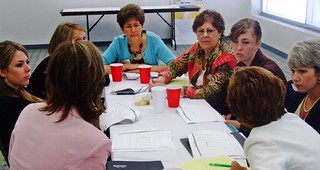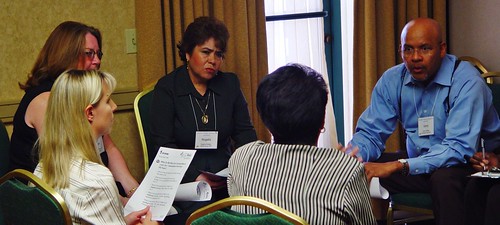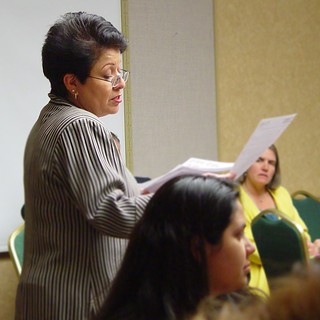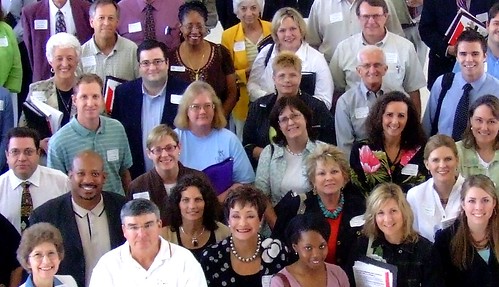 When it comes to leading social change efforts, perhaps the most powerful and least recognized form of leadership is Leading from the Middle – bringing out the best in others, so that they can realize and step into their own potential to create change.
When it comes to leading social change efforts, perhaps the most powerful and least recognized form of leadership is Leading from the Middle – bringing out the best in others, so that they can realize and step into their own potential to create change.
Unlike top-down leadership, Leadership from the Middle is not a function of the position someone holds. It is instead a function of showing someone his or her best self, and creating a favorable environment in which they can be that self. It is the power of all those “best selves” working together that makes Leading from the Middle a quiet force for change. Which means we can all be leaders.
The Leader
Leading from the Middle starts with you – not as “the leader,” but as both leader and follower, working alongside other leaders and followers. And that means that when you are Leading from the Middle, you are leading by example.
Do you want to see others aiming at their potential?
Then YOU aim your own work at both your potential and their potential.
Do you want to see others prioritizing the organization’s impact in the community?
Then YOU prioritize that in your own work.
Do you wish your organization’s leaders would spend more time talking about the community and less time talking about money? Then show them what that looks like with your own work. Show them that a focus on the community can actually be “good for business.”
Model the behaviors you want to see in others. Be an invitation to what is possible by walking that talk. That is what it means to lead by example.
The Followers
Because Leading from the Middle means everyone is both a leader and a follower, often all at the same time, much of a group’s power to create change lies in their knowing and trusting each other.
Take a Whole Meeting
Whatever meetings you normally lead – staff meetings, board meetings, community team meetings – spend one whole meeting sharing, “What is the meandering path of your life that has brought you to care about the work we are doing here?”
Don’t be surprised when people you have known for over a decade end the meeting by sharing, “I never realized…”
Team Updates about Their Passion
Start each meeting with 10 minutes of updates from team members, focusing them back on their passion for the cause.
• Since we last met, what have you seen / experienced that renewed your faith in our purpose?
• Since we last met, what evidence have you seen of our values in action?

This simple 10 minutes will reconnect people with each other, while leaving the outside world (and all its baggage) outside the door. And while some people may feel this is a waste of precious time, those same people will admit that miscommunication and other people problems are far less likely to occur when people take the time to get to know each other.
Web Page with Bios (and Video!)
Help team members get to know each other by posting a web page with their bios. In addition to their photo and brief bio, have them create short videos, answering:
• What excites you about the mission?
• Why is the work our group is doing important to you?
• What is the meandering path of your life that has brought you to care about this work?
Reports
Whether you are reporting to a board, to your supervisor, or giving a committee report at a neighborhood meeting, use your report to share results from your own efforts to have people get to know each other.
Share the questions you have been asking at your own meetings, and share the energy those questions generate. Encourage participants to check out the new web page with all the new videos and bios of team members.
In each of these cases, you will be leading by example. As your own teams get to know each other, you will be sharing the results of those efforts, offering to share with your peers and superiors not only what you and your teams are doing, but also how they might do so, too.
The Reason
Once your team knows and trusts each other, what will you be collectively leading TOWARDS?
Many groups spend meeting after meeting, month after month, talking about the day-to-day. To prevent that, here are some things to try, to help your group regain its power to change the world (or your little piece of that world!).
Make Time for Meaningful Discussion
Whether you are working with a neighborhood team or a board of directors, these ideas will help you spend your time together focused on the future – not rehashing the past.
Reports
Provide reports in video rather than paper. People are more likely to watch a video than read a paper report. Most laptops have all the hardware and software you’ll need to create a video, and YouTube allows you to make videos private. So there is no reason not to try this out!
Consent Agenda
If your group tends to vote on every little thing, switch to a Consent Agenda format. A consent agenda will help you get all the little stuff out of the way quickly, leaving time for the group to talk about the important stuff – the future of your community!
Asking Great Questions Helps Your Team Find Its Voice
Just as it is a powerful tool for getting to know people, the most powerful tool for creating impact is to ask great questions.
Here are a few that have proven over time to generate meaningful discussion:
• When our group is 100% successful, what will our community look like?
• What will indicators be that we are getting close?
• How does the decision we are about to make fit with the success we want to see in our community?
Ultimate Power
We are so used to thinking that power comes from the top down – power as something we wield over others – that Leading from the Middle may not feel very powerful.
And that just may be its greatest strength. Because Leading from the Middle is about the power we all have to build something together that none of us can accomplish on our own. It is the power to bring out the best in others.
And that cannot help but bring out the best in our communities and our world.

I am a community champion (among other things) for my town’s local Circles Initiatve (an initiative dedicated to seeing all people prosper). Many people in our group are trying to leave generational and situational poverty and eliminate barriers in the community to poverty and sustainability. The advice in this article is INVALUABLE!
Leading from the middle is a new term and paragdim. I’ve heard the concepts on front and behind leadership.
Regards
I agree that the phrase “Leading from the Middle” is a new branding on an old concept of empowering others by giving power away and honoring the voice and concerns of those being led. I am ecstatic to see this reshaping of the concept of shared governance to move organizations forward.
I landed here because I was looking to see if the term was already in use, because I, like others, have heard of leading from the front and rear. Already there has been mention of “top down” and “bottom up” and then “middle out” styles too. I am really happy to see the same idea in leadership has been around for some time, and may be picking up steam more and more.
We’re happy you found us, Sophia. Yes, we have been using the term for perhaps a decade. The idea is that one can lead without positional authority – that everyone has the ability to lead change. From our perspective, that is about the power each of us has to ask a different question – the kinds of questions that change thinking, change conversations, change minds, and eventually change results.
I am very grateful to know that one can also lead without being in a position. I will start from here we are not looking up to leaders alone to lead us but we lead together. Thanks very much